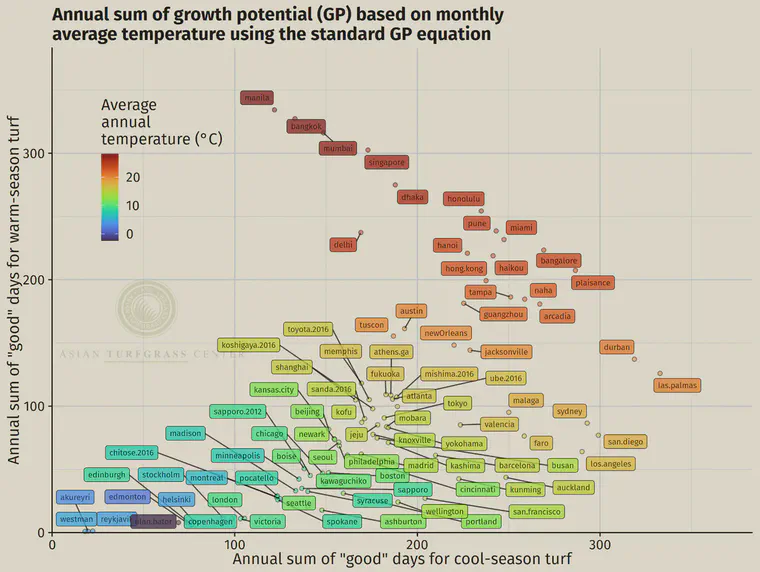Regarding GP and adjustments
This note below, about the temperature-based turfgrass growth potential (GP), has been sitting in my blog_posts.org1 file for a while now, as one of those topics to write about sometime. When I read the note I jotted down when I created this entry, I realized I wouldn’t have to do much to turn this into a blog post. Here it is:
There are so many questions about number of good days and so on, and how to adjust for light, and so on.
Then I see people want to try to fit the model to their own data. But there is a problem with that because a GP of 1 for example is not exactly how grass grows, It is instead a number. But it is a useful number. It’s something that can be compared.
It hits me, as I am writing up a Golf Course Seminar (ゴルフ場セミナー) article, that doing this where everyone makes a custom calculation (or adjustment) then that means it can’t be compared with anyone else. Now you have a number that is a little more meaningful for your site and not meaningful at all for comparison with other locations.
That was the note. Make sense? What I mean is, as more people around the world use the GP, and use calculations that include the GP such as the PACE Turf sand topdressing calculator, or the growth ratio, or the PACE climate appraisal form, or GP as a proxy for season length I suggest using the standard form of the equation.

Sure, you can change the optimum temperature in the equation. Or you can add your own adjustment for light.2 But once you start adjusting the equation, then you’ll find your GP is unique, and suddenly it’s not clear what you are comparing it to. I’ve written about the standard growth potential equations in this post.
There have been times in the past, a decade or so ago, where I said something like, “sure, if you find you get a better fit to growth at you site by adjusting the parameters in the GP equation, go ahead and do so.” Today I am less likely to provide that same advice. Why? Because when someone in New Zealand can report on what the OM accumulation rate has been given a certain GP for the year, and with a certain set of management inputs, and someone in Scotland can do the same, and a golf course superintendent in South Africa or Dubai or Los Angeles can look at those values to see how their results compare, it’s a lot easier to do this when everyone is assured that the same equation for GP is being used at each location.
If you are never going to compare GP at your site to another location, then go ahead and adjust the equation. But when comparisons start getting made, then I’d go back to the standard equation.
See What’s my workflow for more about this. That was the 2017 edition. I’m due for an update. ↩︎
I don’t recommend this. I don’t think it helps much. I’ve made a lot of calculations about this. Here’s a story about light and temperature in a cold place and here’s one about the light and temperature combination in much warmer places. ↩︎